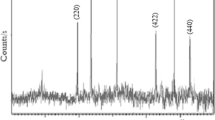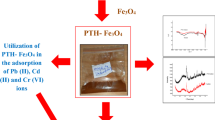Abstract
In this study, Extran (biodegradable surfactant) was used for the preparation of Fe3O4 nanoparticles by microemulsion process to improve removal efficiency of As(III) from aqueous solution. Fe3O4 nanoparticles were characterized by XRD, FTIR, FESEM, TEM, HRTEM, and VSM instrumental techniques. The effect of different parameters such as adsorbent dose, initial As(III) concentration, and solution pH were studied by response surface methodology (RSM) based on Box-Behnken design (BBD). The optimized condition for adsorption of As(III) from aqueous solution was obtained as adsorbent dose of 0.70 mg/g, solution pH of 7.7, and initial As(III) concentration of 33.32 mg/L. In this optimum condition, about 90.5% of As(III) was removed from the aqueous solution. Isotherm studies have been done at optimal condition, and it was observed that the Langmuir isotherm models were fitted well with experimental data having a high correlation coefficient of 0.993. From the Langmuir isotherm data, the maximum adsorption capacity of Fe3O4 nanoparticles was found to be 7.18 mg/g at pH 7.7 in room temperature. This study revealed that Fe3O4 nanoparticles can be used as an efficient, eco-friendly, and effective material for the adsorptive removal of As(III) from aqueous system.








Similar content being viewed by others
Reference
Amini, M., Younesi, H., Bahramifar, N., Akbar, A., Lorestani, Z., Ghorbani, F., et al. (2008). Application of response surface methodology for optimization of lead biosorption in an aqueous solution by Aspergillus niger. Journal of Hazardous Materials, 154, 694–702. doi:10.1016/j.jhazmat.2007.10.114.
Benyettou, F., Milosevic, I., Jc, O., Motte, L., & Trabolsi, A. (2012). Ultra-small superparamagnetic iron oxide nanoparticles made to order. Bioanalysis and Biomedicine, 1–6. doi:10.4172/1948-593X.S5-006
Bilici Basken, M., Aysegul, P., & Turkman, A. (2010). Arsenate removal by coagulation using iron salts and organic polymers arsenate. Ekoloji, 74(February), 69–76. doi:10.5053/ekoloji.2010.7410
Bolt, H. M. (2012). Arsenic: an ancient toxicant of continuous public health impact, from Iceman Ötzi until now. Archives of Toxicology, 86(6), 825–830. doi:10.1007/s00204-012-0866-7.
Brandhuber, P., & Gary, A. (1998). Alternative methods for membrane filtration of arsenic from drinking water. Desalination, 117, 1–10.
Burten, M., & Kurien, K. C. (1959). Effects of solute concentration in radiolysis of water. The Journal of Physical Chemistry, 63, 899–904.
Chandra, V., Park, J., Chun, Y., Lee, J. W., Hwang, I., & Kim, K. S. (2010). Water-dispersible magnetite-reduced graphene oxide composite for arsenic removal. Acs Nano, 4(7), 3979–3986.
Chen, B., Zhu, Z., Ma, J., Qiu, Y., & Chen, J. (2013). Surfactant assisted Ce–Fe mixed oxide decorated multiwalled carbon nanotubes and their arsenic. Journal of Materials Chemistry A, 1, 11355–11367. doi:10.1039/c3ta11827d.
Chen, W., Parette, R., Zou, J., Cannon, F. S., & Dempsey, B. A. (2007). Arsenic removal by iron-modified activated carbon. Water research, 41, 1851–1858. doi:10.1016/j.watres.2007.01.052.
Demarco, M. J., Sengupta, A. K., & Greenleaf, J. E. (2003). Arsenic removal using a polymeric/inorganic hybrid sorbent. Water research, 37, 164–176.
Evans, M. (2003). Optimization of manufacturing processes: a response surface approach.
Fakhri, A. (2014). Application of response surface methodology to optimize the process variables for fluoride ion removal using maghemite nanoparticles. Journal of Saudi Chemical Society, 18, 340–347. doi:10.1016/j.jscs.2013.10.010.
Fan, J., Yi, C., Lan, X., & Yang, B. (2013). Optimization of synthetic strategy of 4′4″(5″)-di-tert-butyldibenzo-18-crown-6 using response surface methodology. Org. Process Res. Dev., 17, 368–374. doi:10.1021/op3003163.
Feng, L., Cao, M., Ma, X., Zhu, Y., & Hu, C. (2012). Superparamagnetic high-surface-area Fe3O4 nanoparticles as adsorbents for arsenic removal. Journal of Hazardous Materials, 217–218, 439–446. doi:10.1016/j.jhazmat.2012.03.073.
Freundlich, H. (1906). User die adsorption in Losungen (adsorption in solution). Journal of Physical Chemistry, 57, 384–470.
Ge, S., Shi, X., Sun, K., Li, C., Uher, C., Baker, J. R., et al. (2009). Facile hydrothermal synthesis of iron oxide nanoparticles with tunable magnetic properties. Journal of physical chemistry C, 113, 13593–13599.
Hao, J., Han, M. J., & Wang, X. M. (2009). Enhanced removal of arsenite from water by a mesoporous hybrid material—Thiol-functionalized silica coated activated alumina. Mesoporous and microporous materials, 124, 1–7. doi:10.1016/j.micromeso.2009.03.021.
Kapaj, S., Peterson, H., & Liber, K. (2006). Human health effects from chronic arsenic poisoning—a review. Journal of Environmental Science and Health, Part A, 4529(41), 2399–2428. doi:10.1080/10934520600873571.
Khalil, M. I. (2015). Co-precipitation in aqueous solution synthesis of magnetite nanoparticles using iron (III) salts as precursors. Arabian Journal of Chemistry, 8, 279–284. doi:10.1016/j.arabjc.2015.02.008.
Korngold, E., Belayev, N., & Aronov, L. (2001). Removal of arsenic from drinking water by anion exchangers. Desalination, 141, 81–84.
Krishna, A. K., Satyanarayanan, M., & Govil, P. K. (2009). Assessment of heavy metal pollution in water using multivariate statistical techniques in an industrial area: a case study from Patancheru, Medak District, Andhra Pradesh, India. Journal of Hazardous Materials, 167, 366–373. doi:10.1016/j.jhazmat.2008.12.131.
Kvítek, L., Panác, A., Kilianová, M., Prucek, R., Filip, J., & Kolar, J. (2013). Remarkable efficiency of ultrafine superparamagnetic iron (III) oxide nanoparticles toward arsenate removal from aqueous environment. Chemosphere, 93, 2690–2697.
Langmuir, I. (1916). The constitution and fundamental properties of solids and liquids. Journal of American Chemical Society, 38, 2221–2295.
Lesen, C., Capat, C., Ruta, F., & Udera, I. (2008). Characterisation of hybrid inorganic/organic polymer-type materials used for arsenic removal from drinking water. Reactive & functional polymers, 68, 1578–1586. doi:10.1016/j.reactfunctpolym.2008.08.011
Lu, T., Wang, J., Yin, J., Wang, A., Wang, X., & Zhang, T. (2013). Surfactant effects on the microstructures of Fe3O4 nanoparticles synthesized by microemulsion method. Colloids and Surfaces A: Physicochemical and Engineering Aspects, 436, 675–683. doi:10.1016/j.colsurfa.2013.08.004.
Lunge, S., Singh, S., & Sinha, A. (2014). Magnetic iron oxide (Fe3O4) nanoparticles from tea waste for arsenic removal. Journal of Magnetism and Magnetic Materials, 356, 21–31. doi:10.1016/j.jmmm.2013.12.008.
Mandal, S., Mahapatra, S. S., Adhikari, S., & Patel, R. K. (2015). Modeling of arsenic (III) removal by evolutionary genetic programming and least square support vector machine models. Environmental Processes, 2, 145–172. doi:10.1007/s40710-014-0050-6.
Mandal, S., Sahu, M. K., & Patel, R. K. (2013). Adsorption studies of arsenic (III) removal from water by zirconium polyacrylamide hybrid material (ZrPACM-43). Water resources and industry, 4, 51–67.
Morillo, D., Pérez, G., & Valiente, M. (2015). Efficient arsenic(V) and arsenic(III) removal from acidic solutions with Novel Forager Sponge-loaded superparamagnetic iron oxide nanoparticles. Journal of Colloid and Interface Science, 453, 132–141.
Ning, R. Y. (2002). Arsenic removal by reverse osmosis. Desalination, 143, 237–241.
Prijic, S., Prosen, L., Cemazar, M., Scancar, J., Romih, R., Lavrencak, J., et al. (2012). Surface modified magnetic nanoparticles for immuno-gene therapy of murine mammary adenocarcinoma. Biomaterials, 33, 4379–4391. doi:10.1016/j.biomaterials.2012.02.061.
Qiu, P., Cui, M., Kang, K., Park, B., Son, Y., Khim, E., et al. (2014). Application of Box-Behnken design with response surface methodology for modeling and optimizing ultrasonic oxidation of arsenite with H2O2. Central European Journal of Chemistry, 12(2), 164–172. doi:10.2478/s11532-013-0360-y.
Roy, P., & Saha, A. (2010). Metabolism and toxicity of arsenic: a human carcinogen. Current Science, 82(1), 38–45.
Sahu, R. C., Patel, R. K., & Ray, B. C. (2013). Process for extraction of fine iron from red mud. India, http://www.allindianpatents.com/patents/255321.
Shaker, S., Zafarian, S., Chakra, C. S., & Rao, K. V. (2013). Preparation and characterization of magnetite nanoparticles by sol–gel method for water treatment. International journal of innovative research in science, engineering and technology, 2, 2969–2973.
Singh, A. P., Srivastava, K. K., & Shekhar, H. (2009). Arsenic (III) removal from aqueous solutions by mixed adsorbent. Indian Journal of Chemical Technology, 16, 136–141.
Singh, T. S., & Pant, K. K. (2004). Equilibrium, kinetics and thermodynamic studies for adsorption of As (III) on activated alumina. Separation and Purification Technology, 36, 139–147.
Su, S. N., Nie, H. L., Zhu, L. M., & Chen, T. X. (2009). Optimization of adsorption conditions of papain on dye affinity membrane using response surface methodology. Bioresource Technology, 100, 2336–2340. doi:10.1016/j.biortech.2008.11.048.
Subramanian, K. G., Raja, S., & Panigrahi, B. S. (2010). Estimation of CTAB in water by ion chromatography. Indian Journal of Science and Technology, 3(7), 718–719.
Temkin, M. J., & Pyzhev, V. (1940). Recent modifications to Langmuir isotherms. Acta Physiochimica URSS, 12, 217–222. doi:10.1016/j.jhazmat.2008.12.093.
Tiwari, D., & Mok, S. (2012). Novel hybrid materials in the remediation of ground waters contaminated with As (III) and As (V). Chemical Engineering Journal, 204–206, 23–31.
Zhang, Z., & Zheng, H. (2009). Optimization for decolorization of azo dye acid green 20 by ultrasound and H2O2 using response surface methodology. Journal of Hazardous Materials, 172, 1388–1393. doi:10.1016/j.jhazmat.2009.07.146.
Acknowledgements
The authors thank the Board of Research in Nuclear Sciences, DAE, India for funding the research project (2013/34/20/BRNS/2708). The authors are also thankful to the National Institute of Technology, Rourkela for providing the research facilities.
Author information
Authors and Affiliations
Corresponding authors
Rights and permissions
About this article
Cite this article
Sahu, U.K., Sahu, M.K., Mahapatra, S.S. et al. Removal of As(III) from Aqueous Solution Using Fe3O4 Nanoparticles: Process Modeling and Optimization Using Statistical Design. Water Air Soil Pollut 228, 45 (2017). https://doi.org/10.1007/s11270-016-3224-1
Received:
Accepted:
Published:
DOI: https://doi.org/10.1007/s11270-016-3224-1




